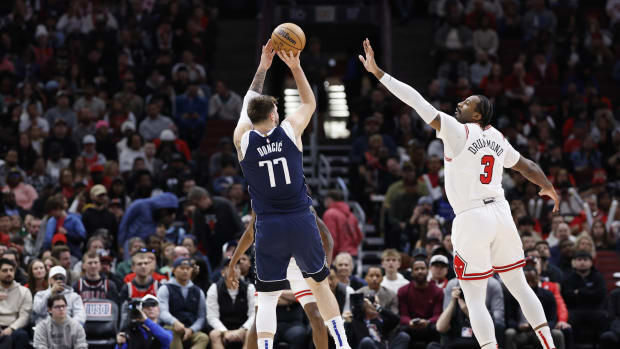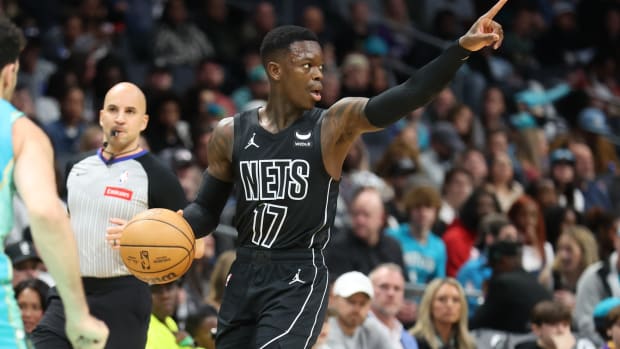Sports and Technology: Innovation defines the latest in hoops' kicks
[video:]
Jordan Brand and Boeing. Adidas and BASF. Nike and NASA. They're all synonymous with innovation and engineering, when researchers and designers must select the optimum materials to use in high-performance situations.
Though carbon fiber and Kevlar are go-to materials in NBA kicks, companies consistently create their own high-tech fabrics, knits and plates in order to increase the strength of basketball sneakers, while decreasing their weight and making them more effective on the hardwood.
Both Nike and its affiliate brand, Jordan, have used carbon fiber for heel counters and plates -- the pieces of the shoe between the sole and the foot. Nike's "Elite" series, a limited edition playoff design, first offered carbon fiber in 2012, giving the shoe a stronger support plate in a thinner, lighter material that offers better response than any other material, says Nike basketball design director Leo Chang. Nike did it again in 2013 in its Jordan 28.
Justin Taylor, a Jordan Brand designer, says the company's Blake Griffin's Super.Fly 2, takes the principles of carbon fiber and puts it in a new Pebax "flight plate" at a lower, more accessible price point for consumers. "Pebax is very lightweight and has as much flexibility as carbon fiber," Taylor says. "It supports the foot, dissipating pressure and offering more return than a standard foam unit."
Adidas took a slightly different approach. To keep its plate light, adidas ditched the carbon fiber, and opted instead for a nylon composite so adidas basketball -- based in Portland -- could stitch the upper directly to the "Sprintframe" plate.
"It has to be soft enough to let the needle go through, but when we give it a certain 3-D shape it becomes very stiff," says Robbie Fuller, a designer at adidas basketball. "It gives us the best rebound and weight-to-strength ratios we need."
As the release of the adidas CrazyLight 3 shows -- at 9.4 ounces it remains the lightest basketball shoe on the market -- reducing layers also eliminates weight. The company's new "Aquatech" material, allows adidas to print on top of a knitted, one-layer four-way stretch fabric.
"Normally if you print ink on stretch it will crack," Fuller says. Now the printed portion of the material doesn't stretch -- or crack -- but the non-printed portions allow for desired stretch. "The need drove innovation."
Nike and Jordan have similar applications. The Super.Fly 2 uses "Hyperfuse" construction for the shoe's upper, a proprietary material that merges a combination of proprietary mesh, synthetic skin and another textile by heat-welding them into a seamless construction that offers breathability and strength in one layer.
"We are diving deep into performance and into new technologies," Taylor says.
For new-era cushioning, adidas has teased the inclusion of its new Boost foam -- in conjunction with BASF, adidas mimicked automobile manufacturing processes to heat-stem individual pea-size thermoplastic polyurethane foam capsules together in running shoes to offer more cushioning and energy return versus traditional EVA foam -- in upcoming basketball lines.
With the rapidly changing material innovations -- not even counting Nike+, which has Nike placing sensors inside shoes to monitor pinpoint movements of players -- Nike has moved into basketball lines now fully 100 percent composite. Jordan and adidas still have some leather -- for the "luxury" -- in certain lines, but performance doesn't leave a lot of room for leather's weighty, one-track use.
To jazz up carbon fiber and newly created knits, strap on Nike's Elite line and experience Kevlar Flywire technology that uses high-strength cables to support the foot, akin to a suspension bridge. Due to Kevlar's high tensile strength -- yarn stretches up to 30 percent, Kevlar just two percent -- designers need less Kevlar Flywire to perform support tasks better. "You look at those numbers and its pretty obvious that Kevlar can do the job in a lighter way," Chang says.
The only limitations found in Kevlar and carbon fiber -- besides the high price tag, of course -- are designers' quandaries, with Kevlar coming in just yellow, black and red and carbon fiber in, well, carbon -- "the consumer wants performance and style," Chang says -- so expect to continue to see new proprietary materials pushing the balance of lightweight and strength, from both adidas and Nike.
Maybe NASA is learning a few things by simply lacing up baller shoes.
Tim Newcomb covers stadiums, design and technology for SI. Follow him on Twitter at @tdnewcomb.


































